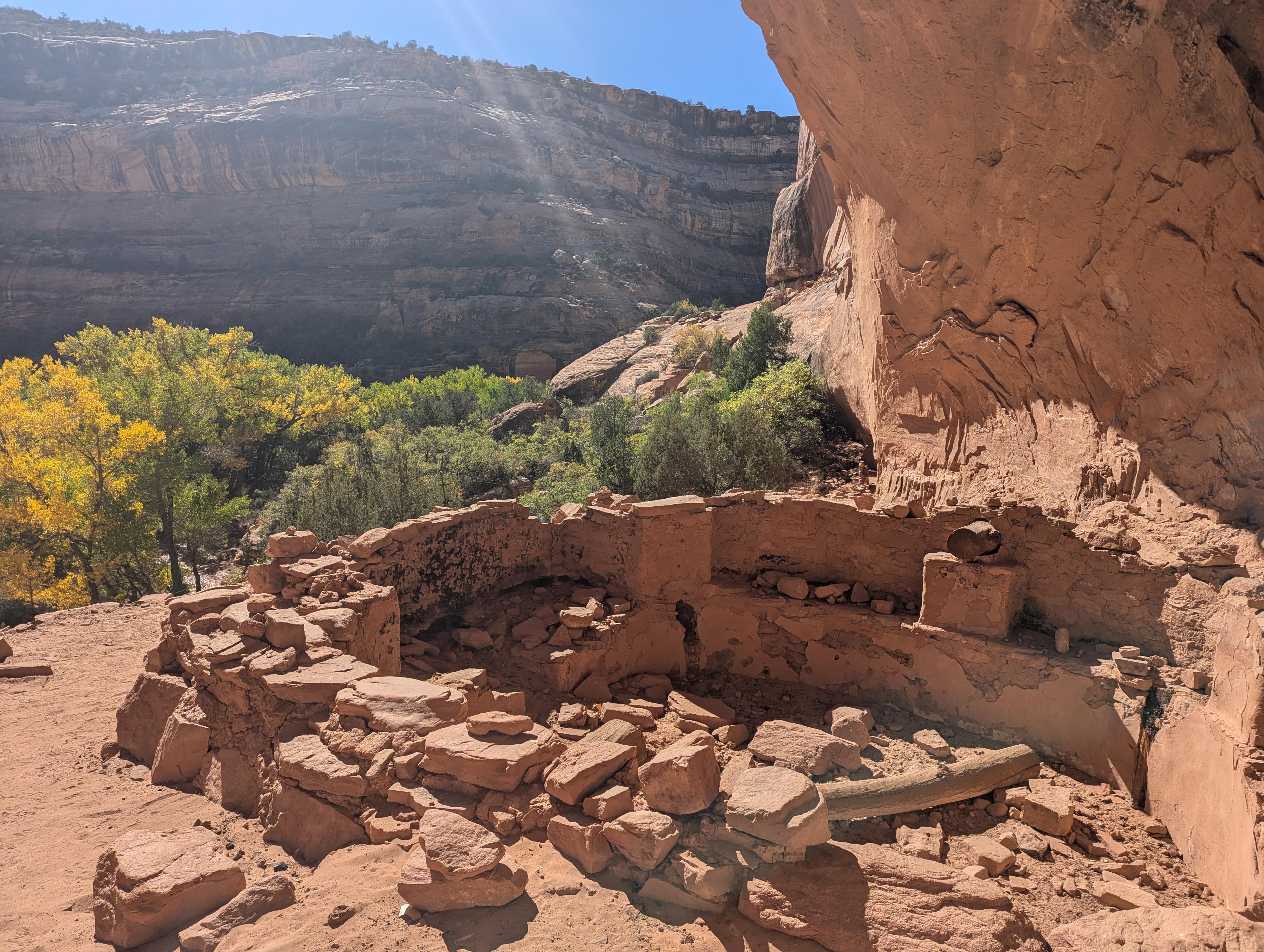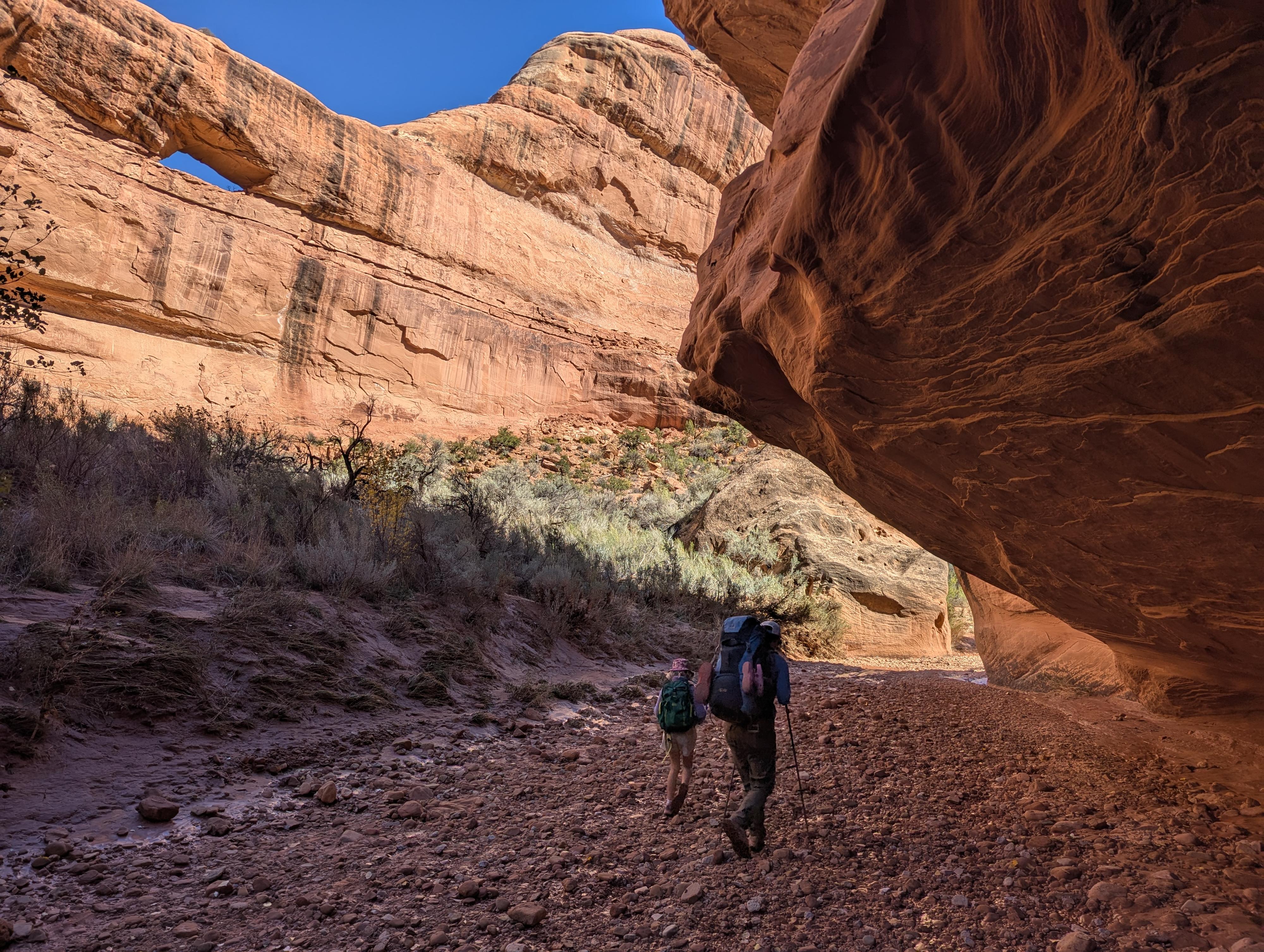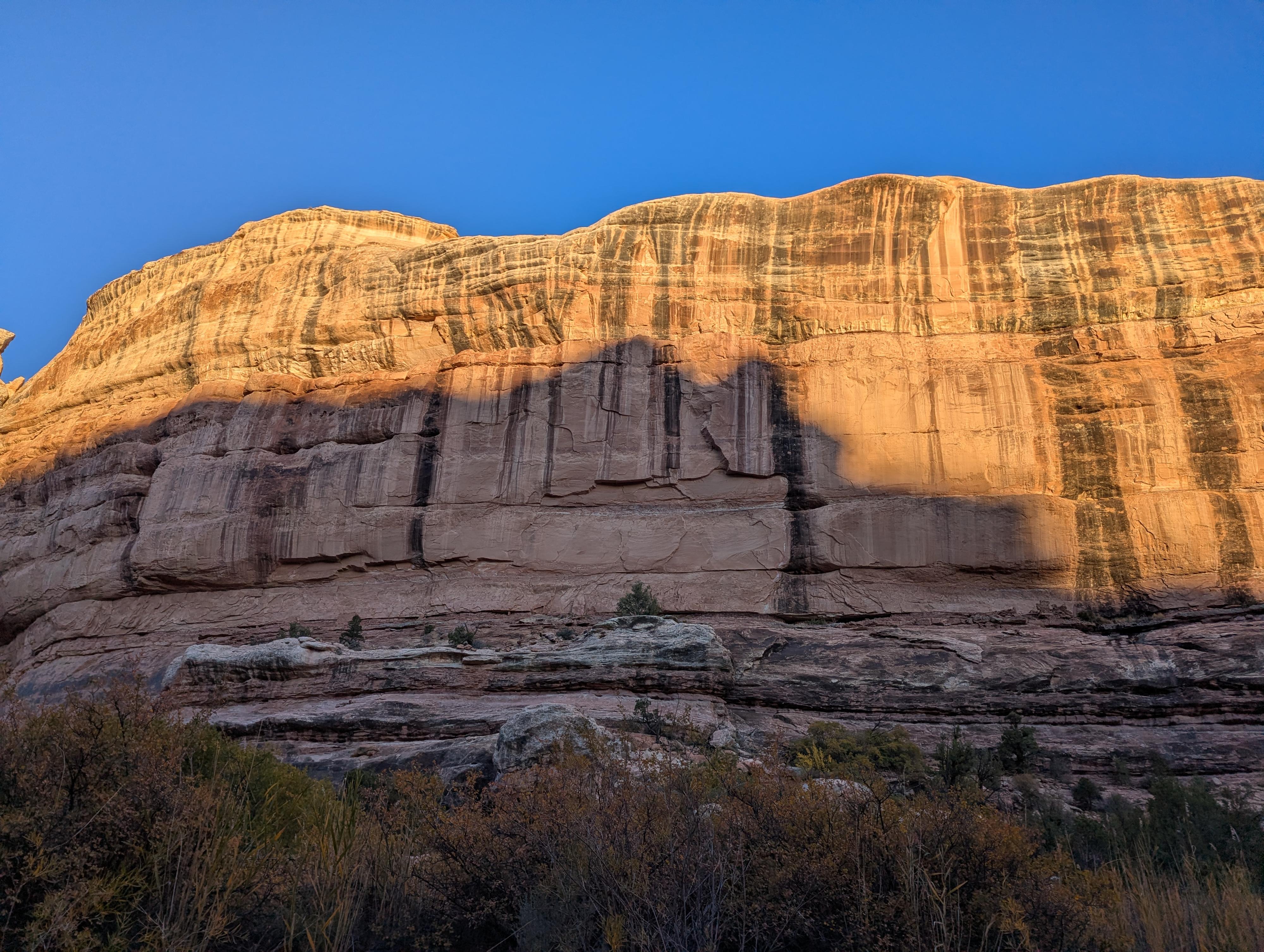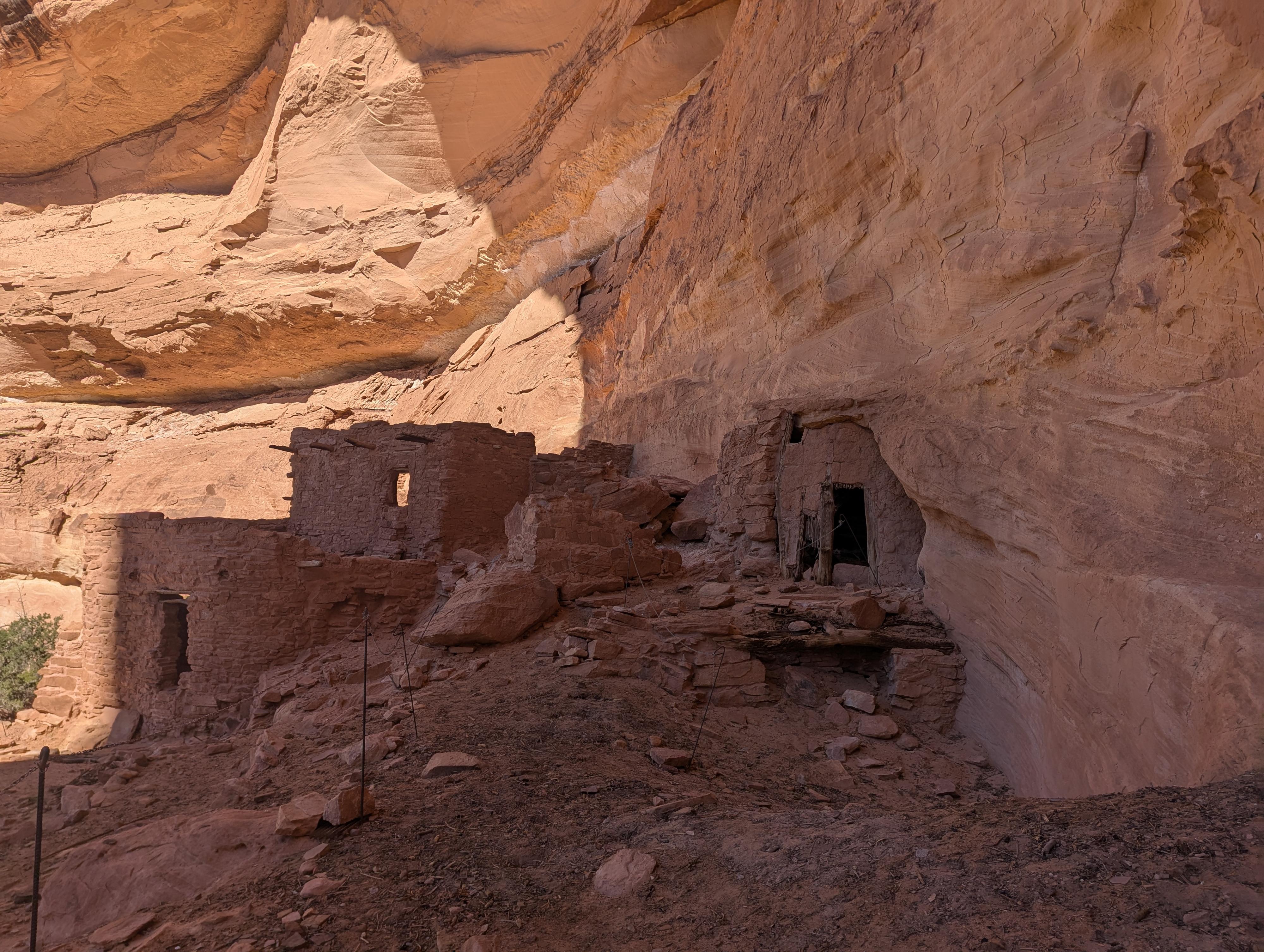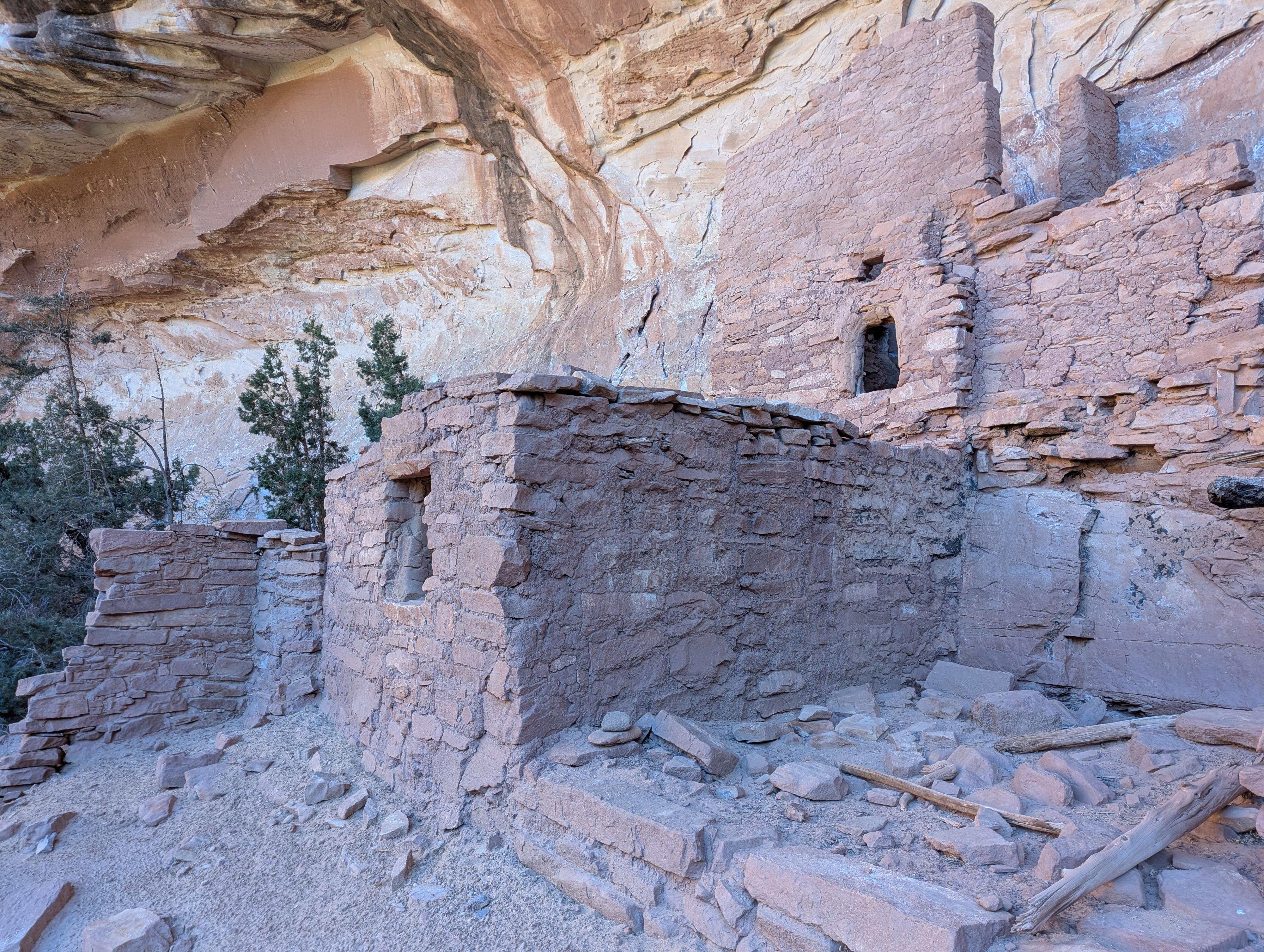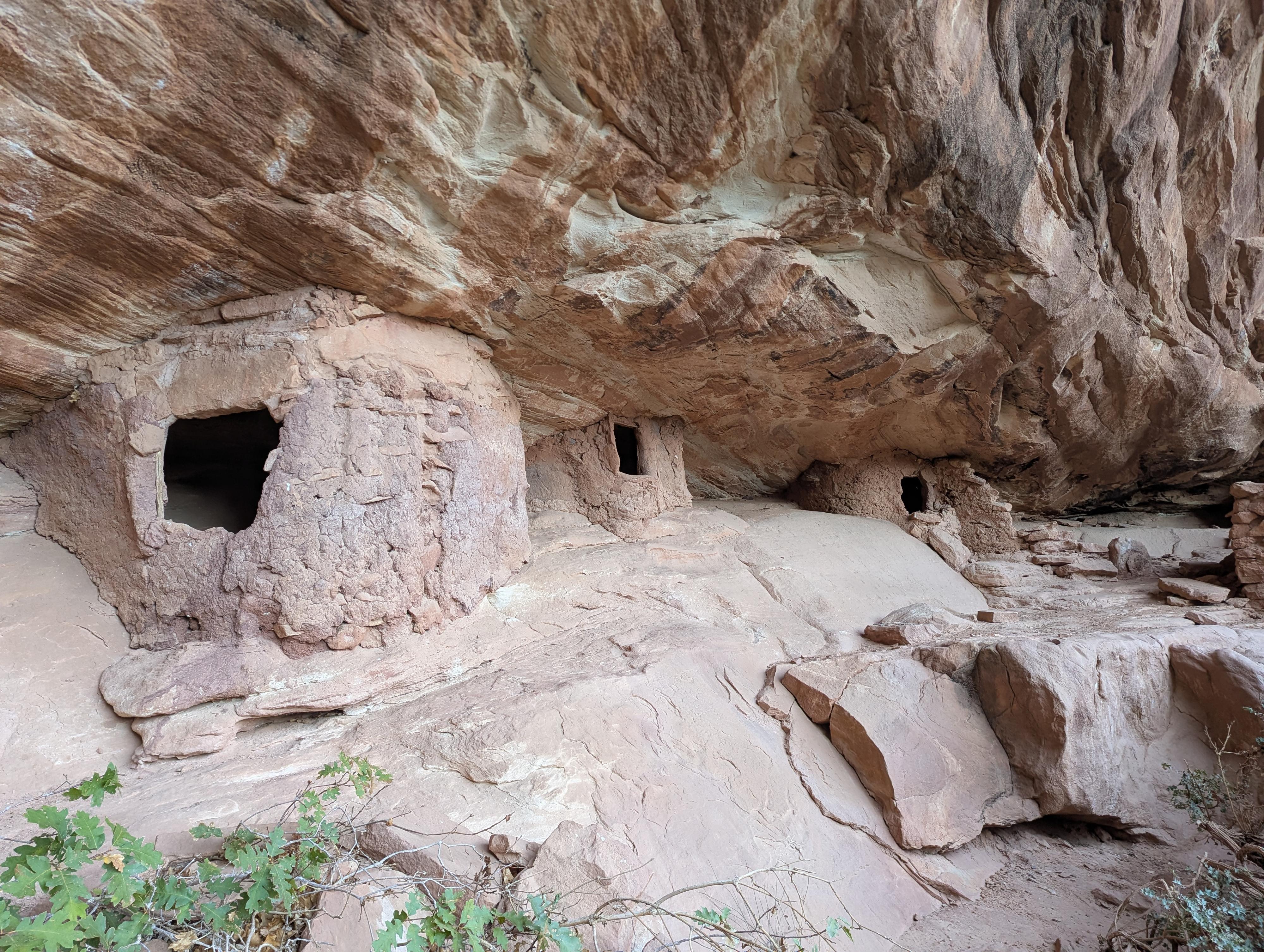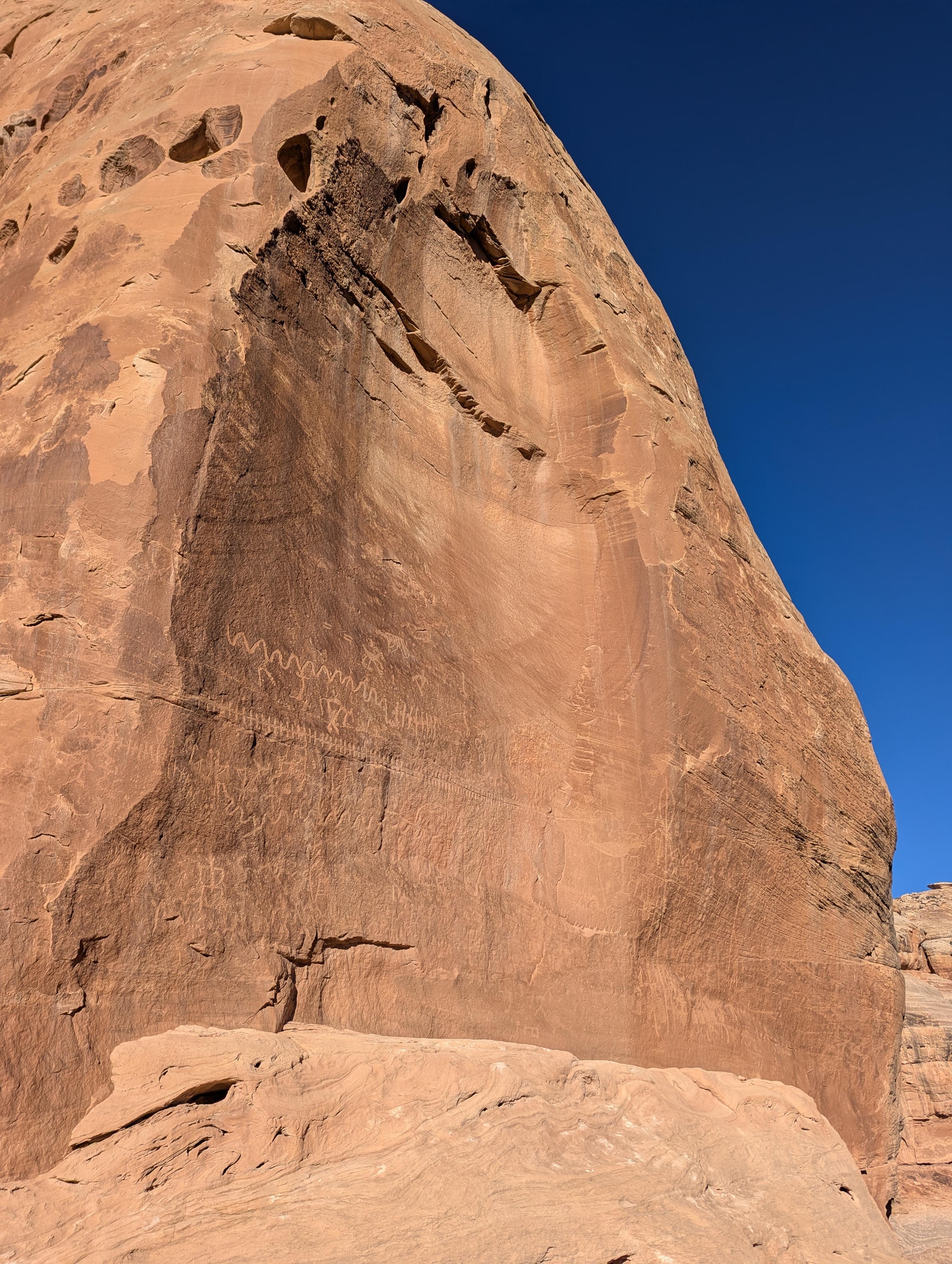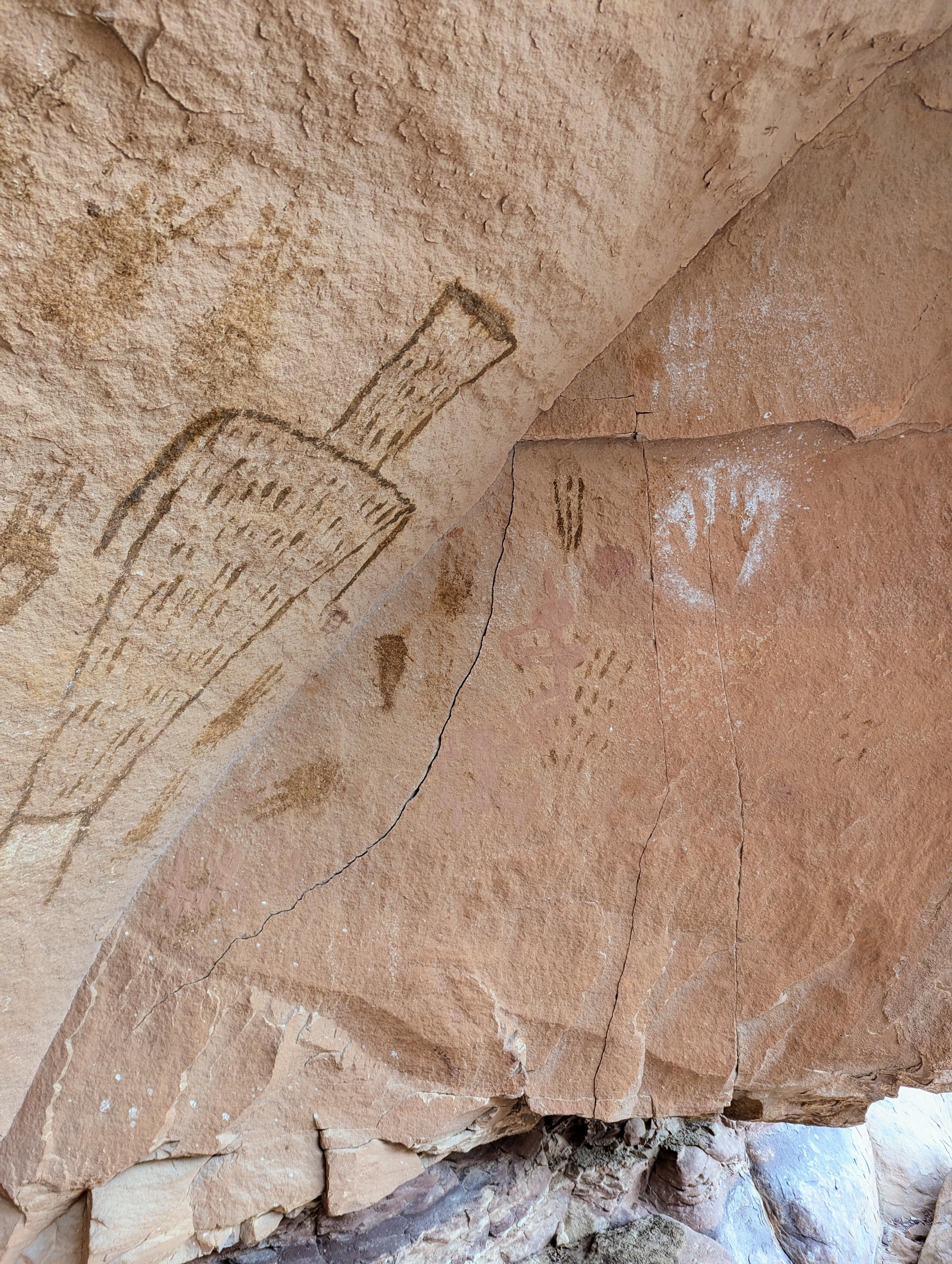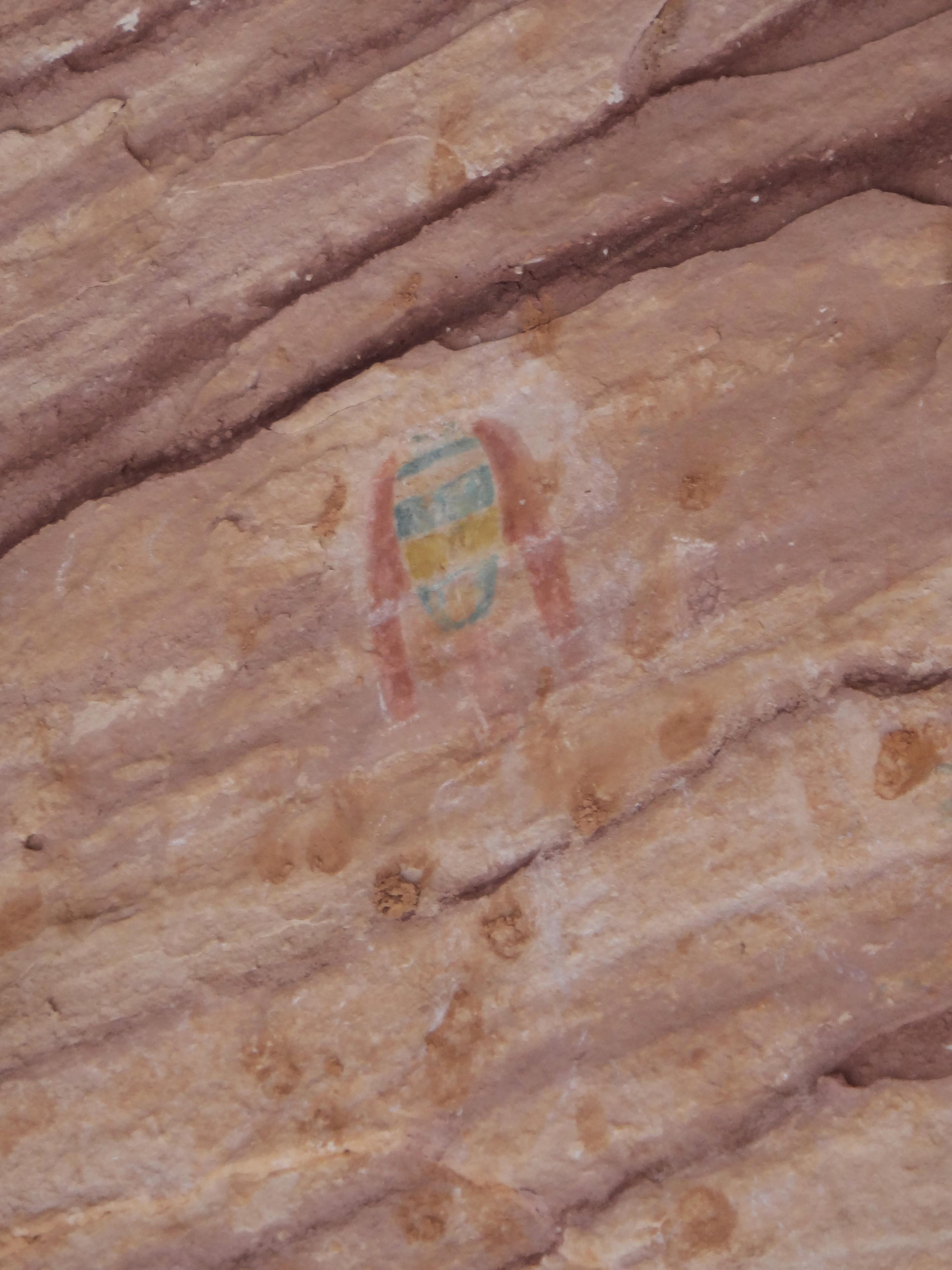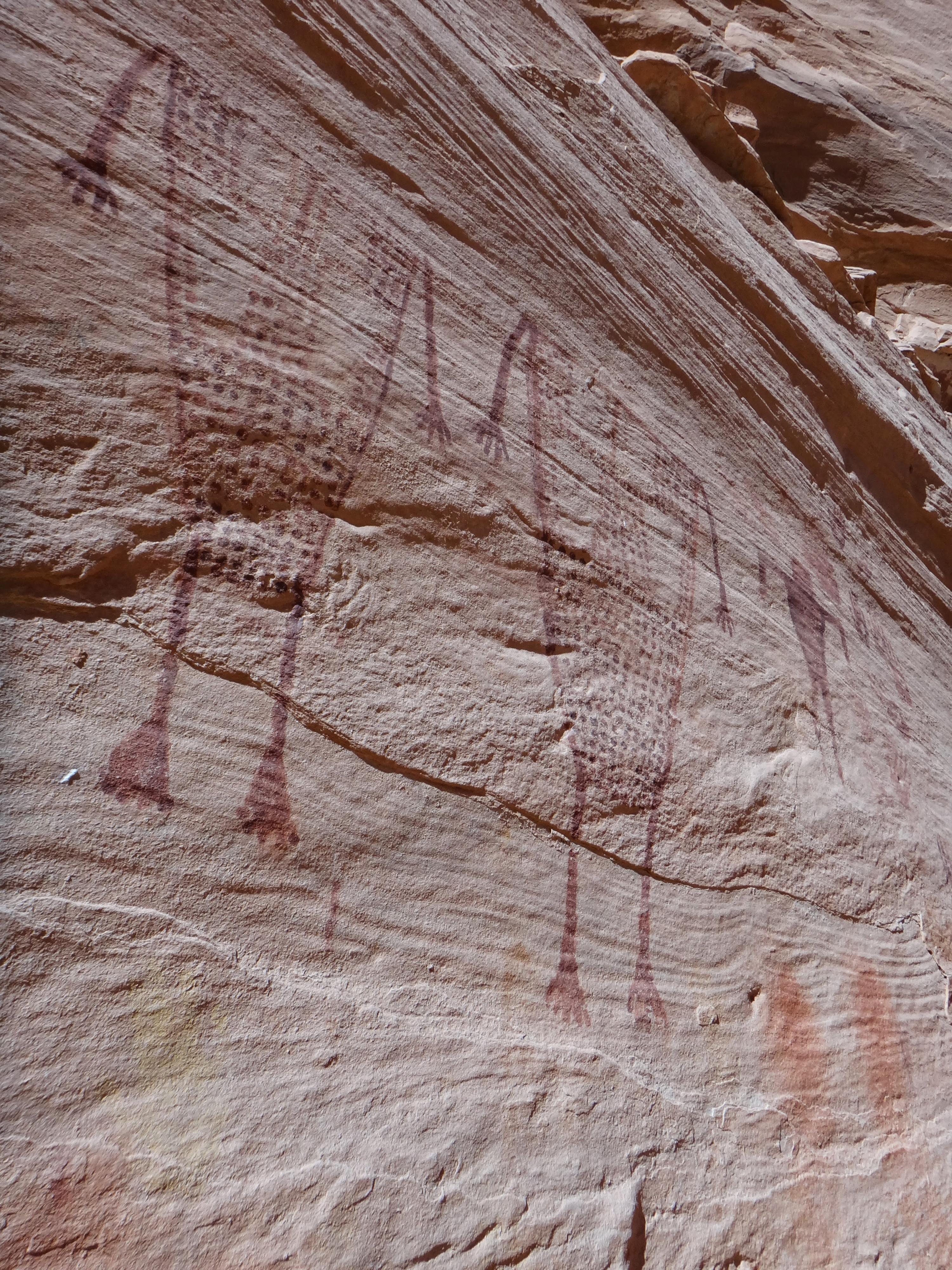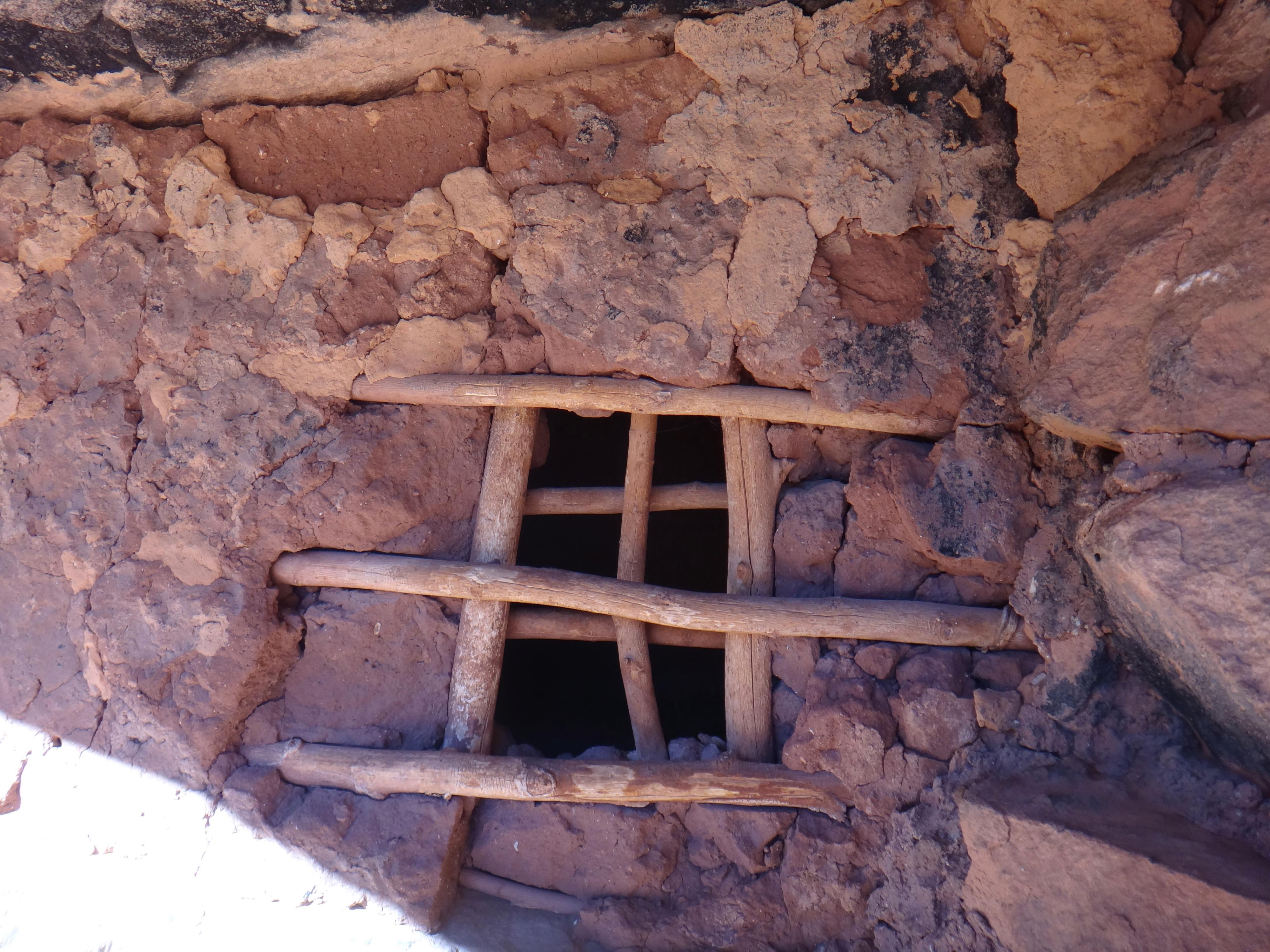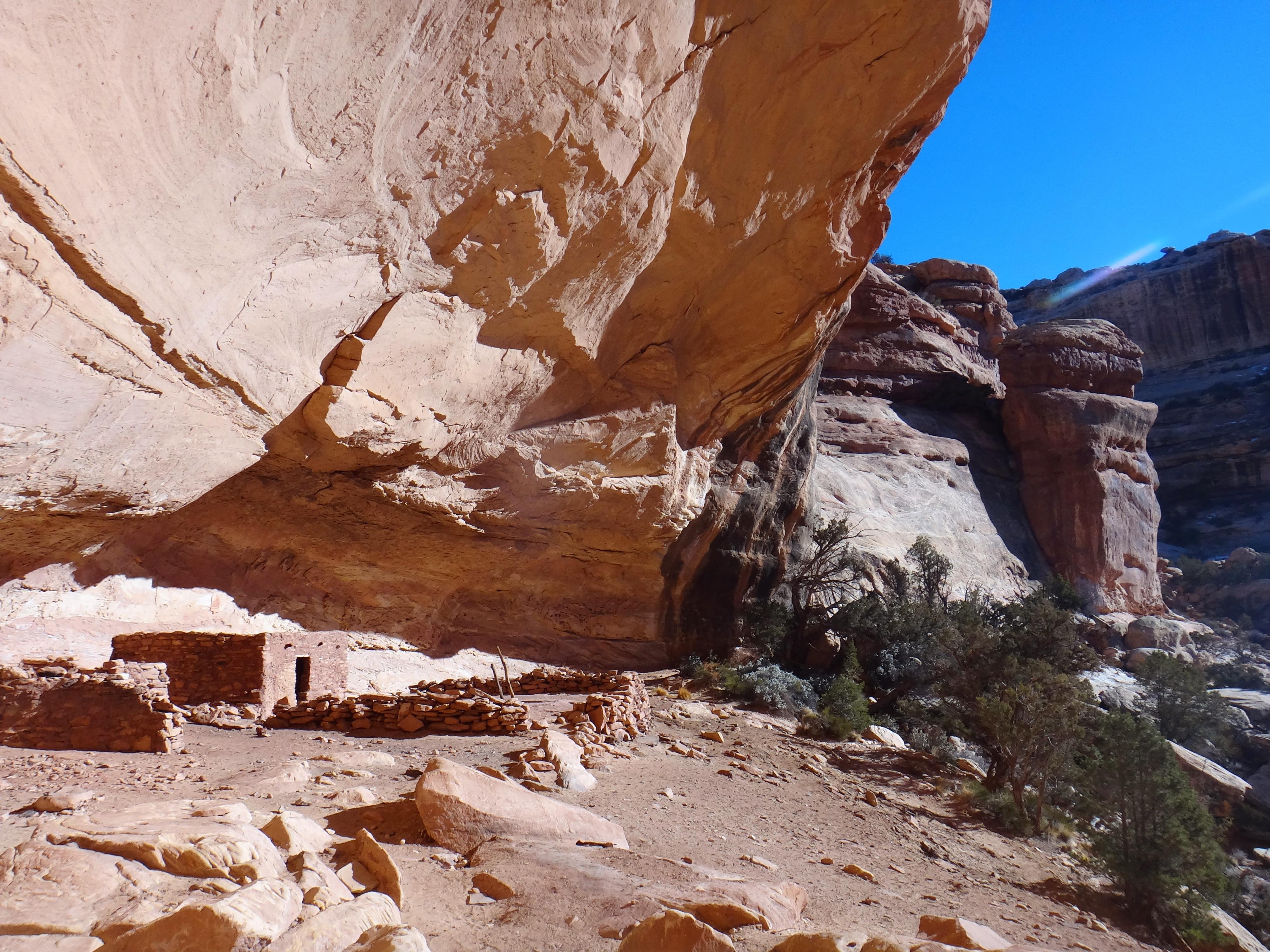 Hiking Kane Gulch to Bullet Canyon
Hiking Kane Gulch to Bullet Canyon
Grand Gulch
Overview
|
Tue 50 | 28 |
Wed 54 | 31 |
Thu 55 | 32 |
Fri 54 | 32 |
Sat 53 | 29 |
| View Full Weather Details | ||||
|
Tue 50 | 28 |
Wed 54 | 31 |
Thu 55 | 32 |
Fri 54 | 32 |
Sat 53 | 29 |
| View Full Weather Details | ||||
Grand Gulch feels like visiting an outdoor museum. It is a fascinating canyon dotted with Native American rock art, granaries, and dwellings. If you like Native American history, it is a place you have to visit! It is also stunningly beautiful scenery.
Grand Gulch is a long drainage. When talking about hiking and backpacking, generally people are referring to about a 50 mile stretch from Kane Gulch Ranger Station, down Kane Gulch to the confluence with Grand Gulch, then down Grand Gulch to the San Juan River. Few hike the entire length in one trip. The upper section, described here, is one of the most popular sections to visit. It has fairly easy access and many sites to visit.
Logistics
Permits: Permits are now required for day hiking or overnight backpacking in Grand Gulch and its tributaries. Day hiking permits do not have a limit, but there is a limit on the number of backpacking permits available. As of the fall of 2025, these seemed fairly easy to get. See the BLM site listed in the permits section for current availability and details.
Route Options: We started from Kane Gulch Ranger Station and exited Sheiks Canyon over 3 days / 2 nights. For two adults and an 8-year-old, this was a good length, though climbing out of Sheiks Canyon is strenuous. If you are a bit more ambitious, I would recommend going from Kane Gulch Ranger Station to Bullet Canyon and out Bullet Canyon. This could be done in 3 days by most groups, or 4 if you want a casual pace. Any route you do, unless it is out and back, will require a car shuttle. For our trip I used a mountain bike. It took about an hour to set up the shuttle at Sheiks Canyon trailhead and bike back to the ranger station (9 miles of biking). Bullet Canyon would probably be similar or a little longer.
Distance Note: We found distances, with side trips and route finding, to be longer than the cleaned-up map. Expect days to feel a bit longer than the mileage may indicate.
Water: WATER TO FILTER FOR DRINKING IS A BIG CONCERN IN GRAND GULCH! You should talk to a ranger about current conditions before you start your trip. Spring and fall GENERALLY see springs flowing. There are a few springs that are typically more reliable than others: Junction Spring, Todie Spring, Coyote Spring, Green Mask Site Spring, Bullet Canyon Junction Spring, and Jailhouse Spring. We carried at least 2 quarts each between water sources and camped near a water source every night. Be sure to treat all water.
Season: Generally spring or fall. Summers can be very hot, and water can be very difficult to find. I have been in Grand Gulch in the winter. Snow and ice made for slow going, so be cautious about setting out if there is snow on the ground.
Camping: BLM asks that you use existing campsites to minimize impacts in the canyon. These are typically near springs. On our October visit, we were surprised to only run into 2 other groups the entire 3 days and had no problem finding campsites near springs. No fires are allowed. No pets are allowed.
Site Etiquette: Visit sites responsibly.
- Treat all cultural sites as sacred places.
- These are not just “ruins” - they are the heritage of living Indigenous peoples.
- Approach sites quietly and thoughtfully.
- Oils from your hands can damage rock art or fragile plaster. Don't touch!
- Don’t lean, sit, or climb on walls - they can crumble easily.
- Never remove or move artifacts (like pottery shards, corn cobs, or tools).
- Use existing paths when possible.
The map and description show the many sites I thought were particularly interesting or popular, but with some exploring and/or binoculars, there are other sites to be seen. Keep an eye out as you hike.
Basketmaker II Period (ca. 500 BCE – 500 CE):
The earliest known farmers in the area. They grew corn and squash, lived in pithouses, and made finely woven baskets instead of pottery.
Basketmaker III Period (ca. 500 – 750 CE):
This period saw the introduction of pottery and the bow and arrow. Small villages began to appear, and people increasingly relied on agriculture.
Pueblo I to Pueblo III Periods (ca. 750 – 1300 CE):
The Basketmaker peoples evolved into the Ancestral Puebloans. They built aboveground stone and adobe structures, developed complex communities, and created the cliff dwellings and kivas seen in Grand Gulch.
After about 1300 CE, many of these ancestral communities migrated southward toward the Hopi Mesas, Zuni lands, and the Rio Grande Valley, likely due to prolonged drought and changing social dynamics. Yet, their descendants - the Hopi, Zuni, Acoma, and other Pueblo peoples - maintain a living connection to this sacred region, as do the Diné (Navajo) and Ute Mountain Ute, who later made the canyons part of their homelands.
Getting There
Kane Gulch Ranger Station
From Blanding, head south on US-191. In about 4 miles, turn right onto UT-95 North toward Hanksville. Follow UT-95N for about 28.4 miles to it's junction with UT-261. Head south on UT-261 toward Bluff/Mexican Hat for about 3.9 miles to where the ranger station is on the left (east) side of the road. There is a restroom at the ranger station, but no water available (as of 2025). This is at about mile post 28.7.
Sheiks Canyon Trailhead
From the ranger station, continue south about 4.6 miles to mile post 24.1.
- Reset your odometer as you leave the highway. ( 12S 596058E 4146688N / 37°27'44"N 109°54'50"W )
- Follow the road, County Road 250, for 3.1 miles to a junction. Go right at this junction. ( 12S 592559E 4145402N / 37°27'03"N 109°57'13"W )
- Continue an additional 1.4 miles to the Sheiks Canyon trailhead. The road is generally passable by all vehicles. Just past the trailhead, the road becomes impassable and should be walked. There is good camping near the trailhead. ( 12S 590409E 4145079N / 37°26'53"N 109°58'40"W )
Bullet Canyon Trailhead
From the ranger station, continue south about 6.9 miles to milepost 21.75, go west and reset your odometer in the good dirt road.
About 1.1 miles from the pavement is the Bullet Canyon trailhead. This road should be passable by all vehicles most of the time. There are several decent primitive camping spots near the trailhead and a pit toilet at the trailhead.
Route
Rock art and historic sites are fragile, non-renewable cultural resources that, once damaged, can never be replaced. To ensure they are protected, please:
- Avoid Touching the Petroglyphs: Look and observe, BUT DO NOT TOUCH!
- Stay on the Trails: Stay on the most used trails when visiting sites, and don't create new trails or trample vegetation.
- Photography and Sketching is Allowed: Do not introduce any foreign substance to enhance the carved and pecked images for photographic or drawing purposes. Altering, defacing, or damaging the petroglyphs is against the law -- even if the damage is unintentional.
- Pets: Keep pets on a leash and clean up after them.
- Artifacts: If you happen to come across sherds (broken pottery) or lithics (flakes of stone tools), leave them where you see them. Once they are moved or removed, a piece of the past is forever lost.
To Grand Gulch (about 4 miles)
From the ranger station, cross the highway and begin following the trail down Kane Gulch. It is well-defined and easy to follow as long as you keep an eye out. Initially in the bottom of the canyon in a fairly wide and shallow canyon.
A little under a mile from the Kane Gulch Ranger Station, the trail hugs the right wall through a narrow passage between a boulder and canyon wall. It is a neat spot!
Below the narrow passage, the canyon slowly deepens. From here, keep an eye out as the trail often leaves on the right to bypass obstacles.
It is about 4 miles from the ranger station to the confluence with Grand Gulch. There is usually a spring at the confluence.
Side Trip to Junction Ruin (less than 1/2 mile round-trip)
From the confluence, hike up Grand Gulch a minute or two. There is a large campsite under trees here on the left. Continue upstream a minute from the campsite to the large alcove on the left. You will see the ruins from a distance as you approach. It is a large and impressive site.
BLM Information on Junction Ruin
Welcome to Junction Ruin.
The site was named because of its location at the confluence of Grand Gulch and Kane Gulch. It dates to Basketmaker III times, though there is little evidence that remains. Pueblo II and III times are better represented. Junction Ruin is an extensive site consisting of three levels. The lower level contains 28 features, the middle includes 14, and the upper alcove, which is now inaccessible, consists of 17 features.
The function of individual structures may not always be apparent, but storage cysts and structures, habitation rooms, kivas, and defensive structures have all been identified at this site. There is also a strong representation of varying architectural types here, including both wet and dry laid adobe masonry and jacal, or wattle and daub (mud plastered over a mesh of sticks).
Specific structures like storage cysts and other above-ground structures were used to store food (corns, beans, and squash) or water. Storage structures tend to be smaller with smaller entryways, which would have been closed using a rock or door slab. At some of the storage units here, you can still see the lintel across the inside top of the doorway, which prevented the door slabs from falling inward. Storage units generally lack any soot and smoke blackening.
Habitation rooms tend to be larger and have thicker walls and a larger entrance than storage units. The walls and ceilings are typically blackened from smoke and soot, indicating that the Ancestral Puebloans made fires inside for warmth or cooking. Ventilators and deflectors are also generally present as a means of ventilating smoke from the structure, similar to a modern chimney.
Three of the features on the main lower level are kivas. They would have had roof beams and roofing material such as juniper bark, and an opening would have been present to enter from the roof into the kiva by use of a ladder. The ventilator shafts, small niches, benches, and plaster are still visible.
The defensive structures at this site have been identified as the entire upper level. To the left of the site and midway up is a ladder platform, which seems to have provided the only access to this upper level. If you look closely above this platform, you will see the remains of a portion of the original ladder, which has now been bolted into the wall for stabilization purposes.
The red mortar remnants on the ceilings and walls to the back of the alcove indicate that there had been a wall or previous structure there which has since fallen.
The rock art at the site includes both petroglyphs (pecked images) and pictographs (painted). There are numerous positive and negative handprints using white and red paint. Yellow and orange abstracts, spirals, and anthropomorphs are also present.
The large rock in the middle of the lower level contains many grinding areas, stone manos to grind corn, while many of the grooves may have been used for sharpening three grinding tools.
Some of the artifacts collected from this site by early archeologists included ceramics, ground stone, lithics, bone tools, and perishable artifacts including sandals, cordage, textiles, basketry, corn, squash, wood, hide, and coprolites. Information can be gained from these artifacts now and in the future with new and updated scientific technology.
The site was stabilized in 1965 and again in 1984. Careful site visitation helps in keeping this site from further deterioration. The rock art was documented in 1982 and was part of a research program in conjunction with the BLM and Earthwatch.
Kane Gulch Confluence to Todie Canyon (about 3 miles)
Head down Grand Gulch. Depending on recent floods, you will likely find a few social trails. Follow whatever social trail looks best heading down the canyon. Sometimes we found it easier to stay in the bottom of the streambed proper. It is a little under a mile to where Turkey Pen Ruin is visible on the right in a high overhang. This is best viewed with binoculars with the current closure.
BLM Turkey Pen Site Closure Information
Temporary restriction of access to Turkey Pen and other archeological sites in upper Grand Gulch
April 18th, 2022
Turkey Pen is an archeological site located down the Kane Gulch trail in the Grand Gulch Wilderness Study Area.
In March 2022, BLM archeologists documented significant erosion and damage to cultural resources at Turkey Pen and other archeological sites in upper Grand Gulch caused by increased visitor use.
Turkey Pen is part of a broader cultural landscape that is sacred to sovereign Tribal Nations and Indigenous people of the southwest. The Bears Ears cultural landscape, and all archeological sites within it, was identified as a unique object in the Monument Proclamation.
To prevent erosion from irreversibly damaging sensitive cultural resources and ensure its proper care and management in accordance with the Antiquities Act of 1906, the BLM will temporarily restrict access to Turkey Pen and other archeological sites in upper Grand Gulch.
Turkey Pen can still be viewed with binoculars from the canyon bottom.
For more information, please contact the Monticello Field Office at (435) 587-1500 or visit the Kane Gulch Ranger Station from 8am to 12pm, March 1st – June 15th and September 1st – October 31st.
Just around the next bend from Turkey Pen Ruin (about 0.2 miles) is Stimper Arch high on the left.
Around the next bend downstream from Stimper Arch is a ruin on a ledge on the right. This is the last major ruin we saw until reaching Todie Canyon.
Todie Canyon Side Trip (1/2+ miles)
Todie Canyon comes in on the left. It is a broad canyon with a couple of campsites at its mouth. Just across from the campsites, tucked under a small overhang, appear to be a couple of granaries.
There is a route out the top of Todie, though on my visit I only went about a mile up canyon before turning around due to lack of daylight. It appears fairly rough terrain the higher you get.
If you hike up Todie, there is generally a good spring about 1/4 of a mile up canyon. The spring is right in the canyon bottom in a grassy area. Look up from the spring, and you will see a long ledge with ruins on the left (north) side of the canyon. There appear to be at least a dozen ruins along the ledge that seem difficult to reach.
Above the spring, it is easy going to a junction with a side canyon coming in on the left. If you stay right, in Todie, the canyon narrows a bit and gets a bit rougher going. About a mile from the confluence of Todie and Grand Gulch, I turned around at some large boulders with what appeared to be a spring-fed pool below them.
Todie Canyon to Coyote Canyon (7-8+ miles depending on side trips)
Between Todie and Coyote Canyons, there is much to see! Keep an eye out on south/southeast-facing alcoves, and keep an eye on the map.
From Todie Canyon, the next bend has several small ruins that appear to be granaries.
The second bend/south-facing overhang downstream from Todie has a smaller but, I think, very interesting two-story ruin. It is on the northeast side of the overhang. You can't see it until you are right up to it. There is a social trail that visits it.
Continuing down, about 1.75 miles from Todie Canyon is the Pouroff. This small dryfall in the canyon bottom often has a large pool at the bottom. There are also campsites above the Pouroff on the south (left) side in this area. You can easily hike past the pouroff on the right side. If the pouroff has water to filter, it would be a nice area to camp.
Below the Pouroff a steep side canyon comes in. Just past this side canyon on the next bend is a ruin on the right in the south-facing alcove. Down from this ruin another side canyon comes in steeply on the right, with Lion Spring across from where it comes in. (seasonal)
Below Lion Spring, at the next bend/south-facing alcove, is Split Level Ruin. This is a fascinating and large ruin. One of my favorites from the trip.
BLM Info On The Site
Welcome to Split Level Ruin
This site was named for the bi-level structure before you. Including the beautiful split-level structure, 18 other structures have been recorded by archaeologists on this level, with six more structures in the inaccessible upper alcove. Additionally, an extensive middens (trash deposit) downslope from the main site area has been identified and recorded.
The Split Level site is believed to have been occupied during the Pueblo II–Pueblo III Period (900–1300 AD). However, there are rock images and artifacts found at the site which indicate an earlier Basketmaker occupation. Archaeologists estimate the population of the Split Level Ruin during Pueblo times to be from 30 to 40 people.
Dating of occupation for the site was done in 1974 when several beams found within the structures were used for dendrochronologic (tree ring) dating. The oldest dates are around 925 AD, while the latest core sample date was around 1255 AD. The dates are approximate because the outside rings of the beams were often weathered and difficult to interpret, but still give us a framework to understand when the site was occupied.
There are three kivas at the Split Level site, identified as partially underground structures that once had roofs made of log beams covered with willows, bark, and, finally, plastered with mud.
There is a structure thought to have acted as habitation rooms with a kiva just below and a small storage structure attached at the upper north end. On the east side of the rooms is a small structure containing some small rock slabs forming a three-sided box-like structure that may have been used for grinding corn.
Other smaller masonry structures at this site, which appear blackened by fire, were probably used as habitation rooms. The smaller structures with no fire-blackened walls, situated along the back wall of the site, were probably used to store crops.
It is thought that the inaccessible structures on the ledges above may have been built for defensive purposes. It is possible that during the prolonged drought of the late Pueblo Period, with poor crops and little food, intra-tribal or intra-family strife became a problem.
Some rock imagery can be found on the large slabs located east of the split-level structure and north of the trail. It includes shield-like figures, concentric circles, spirals, pawprints, handprints, bighorn sheep, and birds.
The archaeological sites of Grand Gulch have sacred spiritual value for the descendants of the Ancestral Puebloans: the Hopi, the Zuni, and the Rio Grande pueblos, and should be treated with care and visited with respect.
There are a couple of sites below Split Level on the right, but the next major site is about 1.85 miles from Split Level (about an 40-60 minutes for most), where an overhang on the right has ruins in it, as well as above it on ledges. This site is quite interesting and has numerous handprints and rock art under the overhang.
From the overhang site, it is about 1.75 more miles to Coyote Canyon. There is at least one more granary that is easy to spot along the way.
Coyote Canyon Side Trip (1 mile round-trip)
I don't know of any ruins in Coyote Canyon, but if you hike up about 1/2 mile there is, generally, a good spring right in the canyon bottom. There are also a couple of campsites right at the confluence of Grand Gulch and Coyote Canyon.
Coyote Canyon to Sheiks Canyon (1.5 miles)
Just a few minutes down Grand Gulch from Coyote Canyon, there is a side "bay" with a hill in it. This isn't quite an alcove, but a large area.
Once you have visited the panel, continue up another minute to a set of granaries hidden behind the bushes. It doesn't seem to see much visitation.
Finally, on the south wall of the bay are additional granaries. It is easiest to hike to them by staying at the level of the rock art and traversing south on mostly slickrock. Once you have visited the south granaries, you can bushwhack down to Grand Gulch proper to pick up the trail again. I thought these were very interesting and worth visiting, but it is brushy and somewhat difficult going.
Continuing down Grand Gulch, it is less than a mile to The Thumb, a prominent rock spire on the right. There is a pouroff here in the canyon.
Scramble up to the base of the thumb. Good route finding keeps this at class 3. Once up, follow a social trail north. It goes to a point with petroglyphs, then heads northwest to the alcove to view some ruins high up.
From The Thumb, it is a little more than 1/2 mile to Sheiks Canyon.
Sheiks Canyon Side Trip (Green Mask Site)
Just 5-10 minutes up Sheiks Canyon is the Green Mask Site on the left, right at a spring. This is one of the jewels of Grand Gulch. Even if you are not exiting out of Sheiks Canyon, definitely take the time to visit the Green Mask Site.
Exit Out Sheiks From Green Mask (3.4 miles / 1.5-3 hours)
Work up Sheiks, staying on the social trails on the left (north). Just above the first bouldery section, a saddle on the left offers a nice viewpoint into Grand Gulch. It is worth the few minute side trip and looks down on The Thumb in Grand Gulch.
Keep working up, following a social trail. A large dryfall can be passed on the right or left with a little scrambling, right is the more common route. This marks the end of the steep section. From here Sheiks becomes wider, less steep, and easy going.
Keep your eye out as you head up Sheiks. A granary, or rather a couple of walls of a granary are visible on the left, followed by a very good granary close to the trail. Not far above the good granary are Yellow House Ruins, a well-preserved ruin complete with roof lashings. Stay left here to get around a small fall, and then cross back to the right and the Sheiks Canyon trailhead in 10-20 minutes.
To Bullet Canyon (1.6 miles)
If exiting out Bullet, continue heading downstream Grand Gulch from the junction of Sheiks and Grand Gulch. At the first bend below Sheiks, look for a ruin in a cave up on the right. It seems easiest from here to stay on the ledge above Grand Gulch, at the level of the cave ruin, as you head downstream. You will encounter 2 more ruins at this level, then reach Bullet Canyon about 1.6 miles downstream from Sheiks Canyon. Bullet is the prominent side canyon coming in on the left. There is usually water at this junction, and it is a good place to fill up before heading up Bullet Canyon.
Out Bullet Canyon (about 7 miles)
Head up Bullet Canyon. It is well traveled. There are a couple of granaries en route to Jailhouse Ruin that is about 2 miles up from Grand Gulch. There is usually filterable water just below Jailhouse. It is a unique and interesting ruin.
About 5-10 minutes above Jailhouse Ruin is Perfect Kiva Ruin. This is a fantastic ruin.
Welcome to "Perfect Kiva" in Bullet Canyon (formally Graham Canyon). You are standing at one of the most recent sites to be occupied on Cedar Mesa and one the first to be excavated, if not the first. Archaeologists have established a chronology for the prehistoric people of the Southwest that lists Archaic (6500 B.C. to 1500 B.C.), Basketmaker (1500 B.C. to A.D. 700), Pueblo (A.D. 750 to 900), Pueblo II (A.D. 900 to 1150), Pueblo III (A.D. 1150 to 1300), Pueblo IV (A.D. 1300 to 1600), and Pueblo V (A.D. 1600 to present). Some of the rock art present at "Perfect Kiva" indicates that the site was first established during the Basketmaker period. The structures you see now are from the Pueblo II and III periods. The first recorded or documented discovery of the site occurred in 1891.
The Navajo call the people that inhabited the Cedar Mesa area the "Anasazi". Many decedents, the Hopi in northeastern Arizona, the Zuni in west central New Mexico, and the Pueblos along the Rio Grande in New Mexico prefer that they are called Ancestral Puebloans. The Hopi refer to them as Hisatsinom. The oral traditions of the Hopi tell of many migrations among their ancestors in the American Southwest. The Hopi believe that these clans left markers through pictographs and petroglyphs to show that they had been at these places or performed certain ceremonies. Many archaeologists also agree with the Hopi migration beliefs. They believe that these migrations took place during three distinct time phases with two to three hundred years in between. These periods are approximately A.D. 200 to 400, A.D. 650 to 725, and A.D. 1060 to 1270.
EARLY EXPLORATION AT "PERFECT KIVA"
Charles McLoyd and Charles Cary Graham of Durango, CO organized the first expedition into Grand Gulch for the purpose of archaeological excavations in January of 1891. Many people feel that these early expeditions by McLoyd, Graham, and others like Richard Wetherill were primarily hunting missions with no archeological training. One has to remember that archeology was a very new field/science at the time and that very few standards had been established.
Before McLoyd and Graham could begin excavating in Grand Gulch and its many side canyons, they first had to find a way to get their horses and supplies down into the canyon bottom. To do this they established a trail into Bullet Canyon a few miles above "Perfect Kiva" on the south-facing canyon side using rock cribbing. This must have been a tremendous amount of work, but work that would have been considered completely worthwhile once they discovered pristine sites like "Perfect Kiva" and "Jailhouse". In the crude field notes that still exist from the McLoyd and Graham expedition, they labeled "Perfect Kiva" Cave #1 and "Jailhouse" Cave #2. This suggests that these might have been the first two sites that the men excavated if their system was in sequential order. Many of these early explorers left their signatures in charcoal or bullet lead on the alcove's walls and rocks. Some of these signatures can be seen here at "Perfect Kiva".
The Wetherill-Grand Gulch Research Project (1986 to 1990) used these signatures of explorers to trace and confirm the early routes of their expeditions. They proved to be a valuable insight into what people associated with the project have termed "reverse archaeology", so please respect and do not touch these valuable signatures. It is a well-known fact that hundreds of artifacts and human remains were sold and shipped to museums throughout the United States, some even to Sweden. Although many of the museums have known the collections were from the Grand Gulch / Cedar Mesa area, it has not been known from which exact site location the artifacts were originally found. The Wetherill-Grand Gulch Project succeeded in establishing the location of many artifacts to specific sites, thus the term "reverse archaeology" or working from original notes, and photographs back to locate the site.
About 6.75 miles from Grand Gulch, keep an eye out on the left as the trail leaves and heads up to the Bullet Canyon Trailhead.
| Kane Gulch Ranger Station |
12S 597570E 4153623N 37°31'28"N 109°53'45"W |
| Gate |
12S 597291E 4153544N 37°31'25"N 109°53'56"W |
| Narrow Passage |
12S 596464E 4153102N 37°31'11"N 109°54'30"W |
| Junction Campsite |
12S 593871E 4152249N 37°30'45"N 109°56'16"W |
| Junction Ruins |
12S 593855E 4152358N 37°30'48"N 109°56'17"W |
| Turkey Pen Ruin |
12S 593054E 4151962N 37°30'36"N 109°56'50"W |
| Stimper Arch |
12S 593293E 4151738N 37°30'28"N 109°56'40"W |
| Ruin On Ledge |
12S 592903E 4151629N 37°30'25"N 109°56'56"W |
| Todie Canyon |
12S 592154E 4149630N 37°29'20"N 109°57'27"W |
| Todie Campsite |
12S 592198E 4149619N 37°29'20"N 109°57'25"W |
| Todie Spring |
12S 592499E 4149801N 37°29'26"N 109°57'13"W |
| Todie Canyon Trailhead |
12S 594719E 4148877N 37°28'55"N 109°55'43"W |
| High Ruins |
12S 592519E 4149949N 37°29'31"N 109°57'12"W |
| Todie Spring 2 |
12S 593413E 4149781N 37°29'25"N 109°56'36"W |
| Below Todie Campsite |
12S 591994E 4149465N 37°29'15"N 109°57'34"W |
| Below Todie Ruins |
12S 591931E 4149582N 37°29'19"N 109°57'36"W |
| Large Ruin |
12S 591455E 4149163N 37°29'05"N 109°57'56"W |
| Pouroff Camping |
12S 590970E 4148866N 37°28'56"N 109°58'16"W |
| Pouroff Pool |
12S 590949E 4148942N 37°28'58"N 109°58'17"W |
| Below Pouroff Ruins |
12S 590552E 4149017N 37°29'01"N 109°58'33"W |
| Lion Spring (approx) |
12S 590348E 4148623N 37°28'48"N 109°58'41"W |
| Split Level Ruin |
12S 590103E 4148724N 37°28'52"N 109°58'51"W |
| Ruin View |
12S 589208E 4148229N 37°28'36"N 109°59'28"W |
| Overhang Rock Art and Ruins |
12S 588184E 4148044N 37°28'30"N 110°00'10"W |
| Campsite |
12S 588018E 4147851N 37°28'24"N 110°00'16"W |
| Granary |
12S 587401E 4147527N 37°28'14"N 110°00'42"W |
| Coyote Canyon |
12S 587130E 4146747N 37°27'49"N 110°00'53"W |
| Coyote Canyon Spring |
12S 587756E 4146950N 37°27'55"N 110°00'28"W |
| Bushwack Granaries |
12S 586883E 4146643N 37°27'45"N 110°01'03"W |
| Petroglyps and Pictographs |
12S 586949E 4146629N 37°27'45"N 110°01'00"W |
| Bushwhack Granaries 2 |
12S 586832E 4146500N 37°27'41"N 110°01'05"W |
| The Thumb Ruins |
12S 586655E 4146130N 37°27'29"N 110°01'13"W |
| Petroglyphs On Point |
12S 586716E 4146066N 37°27'27"N 110°01'10"W |
| Thumb Pour Off |
12S 586715E 4145889N 37°27'21"N 110°01'10"W |
| Bullet Trailhead |
12S 592920E 4143192N 37°25'51"N 109°56'59"W |
| Rim View |
12S 592107E 4142862N 37°25'41"N 109°57'32"W |
| Perfect Kiva |
12S 587734E 4143712N 37°26'10"N 110°00'30"W |
| Jail House |
12S 587299E 4143895N 37°26'16"N 110°00'47"W |
| Granary View |
12S 587033E 4143751N 37°26'11"N 110°00'58"W |
| Granary |
12S 585743E 4144053N 37°26'22"N 110°01'51"W |
| Wall Ruin |
12S 585250E 4144868N 37°26'48"N 110°02'10"W |
| Ruin |
12S 585692E 4145077N 37°26'55"N 110°01'52"W |
| Cave Ruin |
12S 585873E 4145485N 37°27'08"N 110°01'45"W |
| Green Mask Site |
12S 586493E 4145564N 37°27'10"N 110°01'19"W |
| Granary View 2 |
12S 586947E 4145633N 37°27'13"N 110°01'01"W |
| Notch Side Trip |
12S 586927E 4145674N 37°27'14"N 110°01'02"W |
| Granary View |
12S 588579E 4145672N 37°27'13"N 109°59'55"W |
| Granary |
12S 588679E 4145645N 37°27'12"N 109°59'50"W |
| Wall |
12S 589130E 4145714N 37°27'14"N 109°59'32"W |
| Yellow House |
12S 589445E 4145443N 37°27'06"N 109°59'19"W |
| End of Old Road |
12S 589930E 4145184N 37°26'57"N 109°58'60"W |
| Sheiks Trailhead |
12S 590408E 4145079N 37°26'53"N 109°58'40"W |

